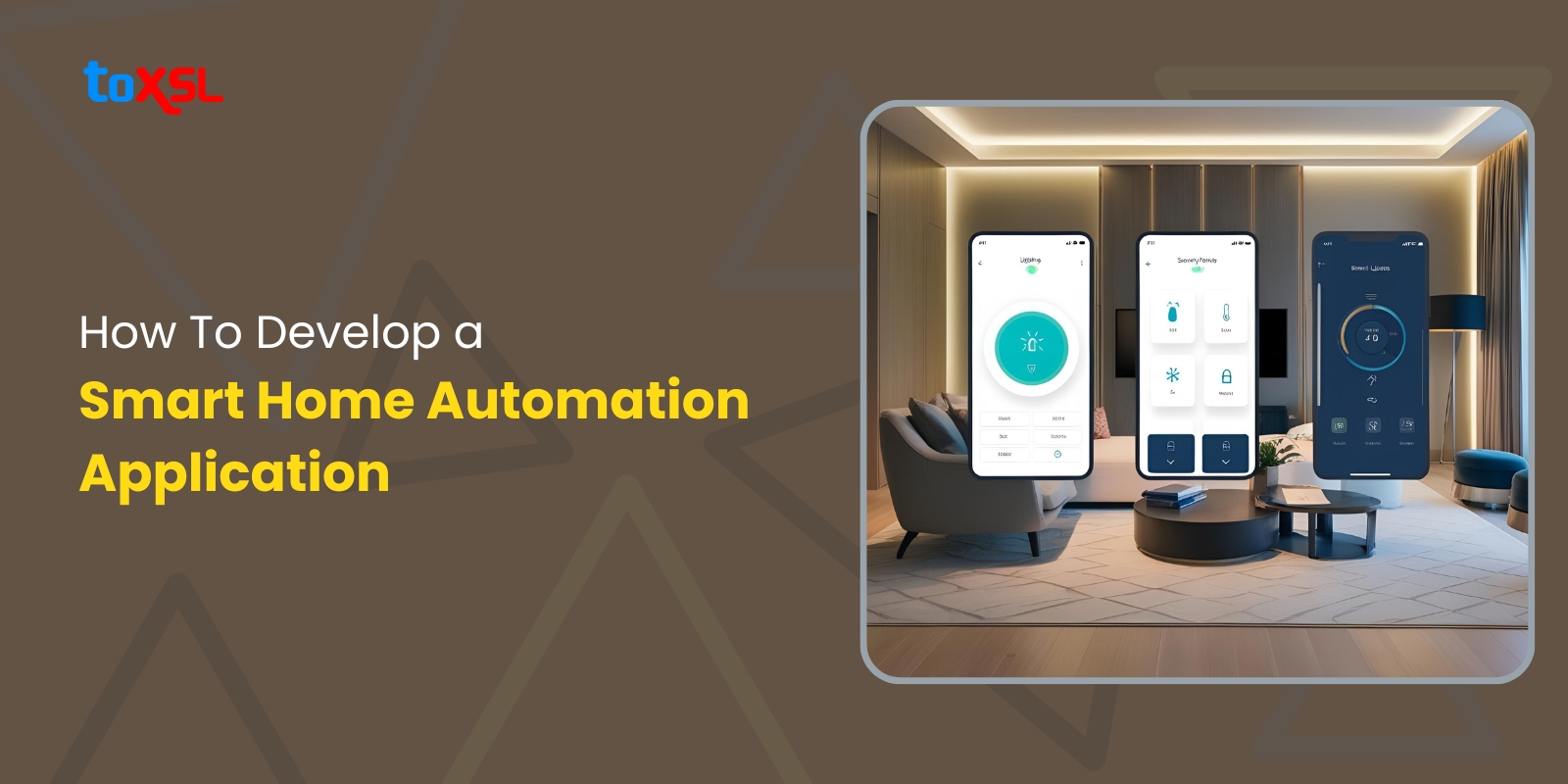- Apr 24, 2025
Share this post on:

Did you know that by 2025, smart home technology is expected to reach 77.6% of households worldwide? Smart home market size is estimated to reach $9.8 billion by 2029, growing at a CAGR of 7.72%.
Are you wondering how to make a smart home app that is special? What important technologies, designs, and trends should you think about? Have you ever wished you could control your home’s lights, temperature, and security from one place? Or maybe you want to save money on energy without doing anything? Smart home automation software makes all this possible, and more.
Smart home automation is a process of connecting devices with the Internet. These devices include lighting, heating, security, tablets, and entertainment. With the rise of the Internet of Things, smart home automation has gained traction, transforming traditional homes into smart homes. The main purpose of a smart home is to revolutionize how people interact with their living spaces. Smart home automation has enhanced user control by integrating numerous devices including smart thermostats, lighting systems, and security cameras, among others. A few smart home automation market drivers are:
- Enhanced consumer demand for convenience
- Advancements in connectivity technologies
- Integration of AI, IoT, and 5G technologies enabling smarter, faster devices
- Growing real estate incorporation of smart home features
- Rising awareness of sustainable and energy-saving solutions
Key Features of Smart Home Automation Application
The best home automation app makes users happy by giving them what they need. It helps people live easier lives. Since there are many apps available, you should create the best one. The first step is to pick the features that users and businesses want. Below are some important features of a smart home app.
Set up Feature: Set up feature help people learn how to use the new device. They help them set it up, create an account, and understand how it works. A simple design also makes it faster and easier to start using the device.
User Roles: User role feature is helpful for people staying at home or at the apartment with roommates. Smart home apps with user roles help keep the home safe and secure.
Smart Reports: The smart home system with IoT lets users collect information. They use sensors to gather this information and make reports. Also, the system has tools to study the data and find the best solutions.
Biometric Access: Biometric access control is an important feature that keeps the smart home safe. It uses special scanners to take pictures of your fingertips and save them to check your identity.
Voice Recognition: The best smart home app uses voice recognition to make things simple and safe. It can hear the user’s voice, even if there is noise, and turn it into digital instructions to use later.
Face Recognition: Like voice recognition, the smart home uses face recognition to know the faces of people living there. The app can warn the person if it sees someone suspicious nearby.
Customization: The app can change how appliances work based on what the customer likes. For example, it learns the customer’s favorite air conditioner temperature and light brightness.
Step-by-Step Guide to Developing a Smart Home Automation Application
1. Define Your Requirements: Before coding, clarify what problem your app solves. Are you focusing on security, energy management, entertainment, or multi-device control? Define your target users—tech-savvy homeowners, elderly users needing assistance, or property managers—and tailor features accordingly.
2. Select Core Features: Some essential features to consider include:
- Remote control of devices (lights, thermostats, locks)
- Scheduling and automation rules (e.g., turning off lights at bedtime)
- Voice assistant integration (Amazon Alexa, Google Assistant, Apple HomeKit)
- Real-time alerts and notifications (security breaches, appliance status)
- User profiles and permissions for multi-user households
- Energy consumption monitoring and reporting
3. Right Technology Stack: Ensure your app supports popular smart devices and protocols like WiFi, Bluetooth, Zigbee, or Z-Wave. Wireless systems dominate with a 59.3% market share due to ease of installation and flexibility.
Use scalable cloud platforms (AWS, Azure, Google Cloud) for data storage, device management, and AI processing.
Develop native apps for iOS and Android or use cross-platform frameworks like React Native or Flutter.
4. Intuitive User Interface: Smart home apps must be user-friendly for all ages. Focus on:
Simple navigation and clear icons
Voice control options
Customizable dashboards
5. Robust Security Measures: Security is paramount due to privacy concerns. Implement:
Biometric authentication and multi-factor login
Secure identity verification for access control
Regular software updates to patch vulnerabilities
6. Test Thoroughly: Test for compatibility with various smart devices and network conditions. Simulate real-world scenarios like power outages, network failures, and multiple user interactions to ensure reliability.
Benefits of Smart Home Automation Software
Smart home technology is growing fast. More and more people are choosing smart devices to make their homes safer, more comfortable, and energy-efficient. But what exactly can smart home automation software do for you? Let’s explore the many benefits easily and clearly.
Enhanced Home Security: There is a famous saying, “Safety comes first.” Safety is very important to everyone. One big benefit of a home automation system is that it keeps your home very secure. With this system, you can lock your doors just by tapping your phone. You can also see who is coming into your home and get a message every time someone enters. This helps people feel safer and less worried about their homes.
Safety on Appliances: Home automation adds extra protection for your home and family. It lets you control lights, power, heating, and other devices easily from your phone. This helps prevent fires and other serious problems. It can also send alerts to your neighbors so they can act fast to keep everyone safe.
Energy Efficient: Automating your home helps you use less energy. It turns off devices and appliances when no one is using them. You can control heating and cooling in your home to save energy all day. Lights, air conditioners, and other devices can switch off automatically when they are not needed. Using less energy means you will pay less on your monthly energy bills.
Convenience: With a home automation system, you can easily control lights, heating, and electrical devices using a remote or your phone. Sometimes when you come home, the house feels too hot or too cold, and it takes time to fix the temperature. But with home automation, you can change the thermostat from anywhere before you arrive. This makes coming home more comfortable and convenient.
More Productive: We live in a fast-moving world, and we don’t have much time to think about our home. That’s why home automation is very helpful for busy people who have a lot to do at work.
Conclusion
Creating a smart home app is a smart idea because the market is growing fast and technology is getting better. If you make the app simple to use, safe and use smart tools like AI and IoT, your app will work well now and later.
The smart home market is expected to grow a lot by 2029, so now is the best time to create new ideas and be a leader. ToXSL Technologies is a top company that builds smart home automation apps and can help you change your lifestyle. Contact us today.












